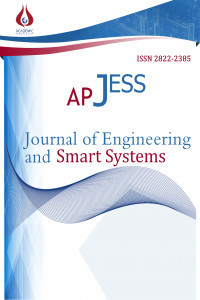Fluidized Electrooxidation Process Using Three-Dimensional Electrode for Decolorization of Reactive Blue 221
Particle Electrode, Three-dimensional electrode, Electrochemical processes, Electrooxidation, Decolorization
Fluidized Electrooxidation Process Using Three-Dimensional Electrode for Decolorization of Reactive Blue 221
Particle electrode, three-dimensional electrode, electrochemical processes, Electrooxidation, decolorization,
___
- K. Ulucan-Altuntas and F. Ilhan, “Enhancing Biodegradability of Textile Wastewater by Ozonation Processes: Optimization with Response Surface Methodology,” Ozone: Science and Engineering, 2018, doi: 10.1080/01919512.2018.1474339.
- M. Sarıoğlu Cebeci̇, S. Selçuk, “Atıksudan Fotokatalitik Yöntemle Boya Giderimi Ve Mineralizasyonu”, Akademik Platform Mühendislik ve Fen Bilimleri Dergisi. Vol. 8(3), pp. 533-539, 2020, doi: 10.21541/apjes.625338
- F. Ilhan, K. Yetilmezsoy, A. Kabuk, K. Ulucan, T. Coskun, and B. Akoglu, “Evaluation of operational parameters and its relation on the stoichiometry of Fenton’s oxidation to textile wastewater,” Chemical Industry and Chemical Engineering Quarterly, 2017, doi: 10.2298/ciceq150907048i.
- A. Aygun, B. Eren, Elektrokoagülayon Yöntemiyle Reaktif Yellow 160 Boyar Maddesinin Giderimi. Akademik Platform Mühendislik ve Fen Bilimleri Dergisi. 5(3): 10-18, 2017, doi: 10.21541/apjes.
- E. GilPavas, P. Arbeláez-Castaño, J. Medina, and D. A. Acosta, “Combined electrocoagulation and electro-oxidation of industrial textile wastewater treatment in a continuous multi-stage reactor,” Water Science and Technology, 2017, doi: 10.2166/wst.2017.415.
- A. Deghles and U. Kurt, “Treatment of raw tannery wastewater by electrocoagulation technique: optimization of effective parameters using Taguchi method,” Desalination and Water Treatment, 2016, doi: 10.1080/19443994.2015.1074622.
- C. Zhang, Y. Jiang, Y. Li, Z. Hu, L. Zhou, and M. Zhou, “Three-dimensional electrochemical process for wastewater treatment: A general review,” Chemical Engineering Journal. 2013, doi: 10.1016/j.cej.2013.05.033.
- R. Misra, N. N. Neti, D. D. Dionysiou, M. Tandekar, and G. S. Kanade, “Novel integrated carbon particle based three dimensional anodes for the electrochemical degradation of reactive dyes,” RSC Advances, vol. 5, no. 14, pp. 10799–10808, 2015, doi: 10.1039/c4ra13550d.
- X. Zhu, J. Ni, X. Xing, H. Li, and Y. Jiang, “Synergies between electrochemical oxidation and activated carbon adsorption in three-dimensional boron-doped diamond anode system,” Electrochimica Acta, vol. 56, no. 3, pp. 1270–1274, 2011, doi: 10.1016/j.electacta.2010.10.073.
- M. R. Foroughi, M., Rahmani, A. R., Asgari, G., Nematollahi, D., Yetilmezsoy, K. and Samarghandi, “Optimization of a three-dimensional electrochemical system for tetracycline degradation using box-behnken design.,” Fresenius Environmental Bulletin, vol. 27, no. 3, pp. 1914–1922, 2018.
- F. Lücking, H. Köser, M. Jank, and A. Ritter, “Iron powder, graphite and activated carbon as catalysts for the oxidation of 4-chlorophenol with hydrogen peroxide in aqueous solution,” Water Research, 1998, doi: 10.1016/S0043-1354(98)00016-5.
- M. H. Zhou and L. C. Lei, “Electrochemical regeneration of activated carbon loaded with p-nitrophenol in a fluidized electrochemical reactor,” Electrochimica Acta, vol. 51, no. 21, pp. 4489–4496, 2006, doi: 10.1016/j.electacta.2005.12.028.
- E. Andrés García, M. Agulló-Barceló, P. Bond, J. Keller, W. Gernjak, and J. Radjenovic, “Hybrid electrochemical-granular activated carbon system for the treatment of greywater,” Chemical Engineering Journal, vol. 352, no. April, pp. 405–411, 2018, doi: 10.1016/j.cej.2018.07.042.
- M. Alkan, S. Çelikçcapa, Ö. Demirbaş, and M. Dogan, “Removal of reactive blue 221 and acid blue 62 anionic dyes from aqueous solutions by sepiolite,” Dyes and Pigments, 2005, doi: 10.1016/j.dyepig.2004.07.018.
- K. Ulucan-Altuntas, E. Debik, C. B. Ustundag, M. D. Guven, and K. A. Gocen, “Effect of visible light on the removal of trichloromethane by graphene oxide,” Diamond and Related Materials, p. 107814, 2020, doi: https://doi.org/10.1016/j.diamond.2020.107814.
- A. Gunay, B. Ersoy, S. Dikmen, A. Evcin, “Investigation of equilibrium, kinetic, thermodynamic and mechanism of Basic Blue 16 adsorption by montmorillonitic clay”, Adsorption, vol.19, pp.757–768, 2013, doi: 10.1007/s10450-013-9509-4
- F. Ilhan, K Ulucan-Altuntas, Y. Avsar, U. Kurt, A. Saral, “Electrocoagulation process for the treatment of metal-plating wastewater: Kinetic modeling and energy consumption” Frontiers of Environmental Science & Engineering, vol. 13(5), pp.73, 2019, doi: 10.1007/s11783-019-1152-1
- H. N. Tran, S. You, A. Hosseini-Bandegharaei, H. Chao, “Mistakes and inconsistencies regarding adsorption of contaminants from aqueous solutions: A critical review” Water Research, vol:120, pp. 88-116, 2017, doi: 10.1016/j.watres.2017.04.014
- Yayın Aralığı: Yılda 3 Sayı
- Başlangıç: 2022
- Yayıncı: Akademik Perspektif Derneği
Hilmi Evren ERDİN, M. Burcu SILAYDIN AYDIN, Nur Sinem PARTİGÖÇ, Hayat ZENGİN ÇELİK, Arzu PALAZCA, Çiğdem HOROZ
Esra GENCELİ, Gülsüm ÜRPER, Reyhan ŞENGÜR, Türker TÜRKEN, İsmail KOYUNCU
An Expert System to Predict Eye Disorder Using Deep Convolutional Neural Network
Moahmmed Rashid AHMED, Saadaldeen Rashid AHMED, Adil Deniz DURU, Osman Nuri UÇAN, Oğuz BAYAT
Çelik Kolon Taban Levhalarının Mekanik Davranışlarının İncelenmesi
Mehmet Zahid YILDIRIM, Caner ÖZCAN, Okan ERSOY
Alparslan Serhat DEMİR, Mine Büşra GELEN, Şeyma ACIR
Fotometrik Flicker Olayının İnsana Etkileri ve Bunların Tıbbi Olmayan Tespit Yöntemleri
Cenk YAVUZ, Ceyda AKSOY TIRMIKÇI
İstanbul Boğazı’nda Transit Geçiş Yapan Gemilerin Egzoz Gazı Emisyonlarının İncelenmesi
İvmeölçer ve Nesnelerin İnterneti Tabanlı Gerçek Zamanlı İnsan Aktivite Tespiti
